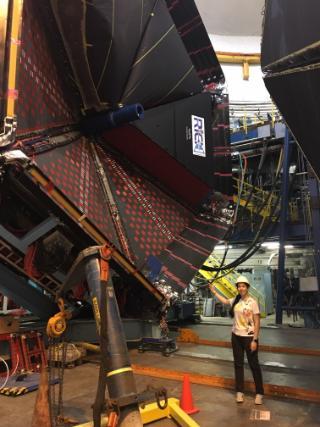Dr Rachel Montgomery
Published: 11 November 2019
Experimental Hadron Physics

Dr Rachel Montgomery
School of Physics and Astronomy
Type of fellowship STFC Ernest Rutherford Fellowship
Area of research Experimental Hadron Physics
Why did you choose to pursue a fellowship in your research career?
After completing my MSci in Physics and PhD in Experimental Nuclear Physics at Glasgow, I moved to Italy to take up my first post-doc at a national nuclear physics laboratory in Frascati, just outside of Rome. Upon completion, I returned to Glasgow to take up a new post-doc position. It was during this post-doc that I was encouraged to apply for a Fellowship – I wasn’t aware that it was an option, or what kind of opportunity it offered before then. The STFC ERF which I have secured is a five-year research fellowship. I chose to pursue this to gain independence and develop my research portfolio, with a view to growing my own research program and team. My ultimate career goal is to secure a permanent position within an academic or scientific research laboratory. A fellowship provides an unrivalled stepping stone towards achieving this, offering a transition between the stage of post-doctoral researcher on another PI’s grant to independent researcher. Obtaining this fellowship is an exciting opportunity to have the freedom to create my own research path and follow the areas which interest me the most.
Why work at the University of Glasgow?
The University of Glasgow has a strong research programme - this was an essential factor for me. I will hold my fellowship within the same research group as my last post-doctoral position. The group has very strong international links, a wealth of broad expertise, both complementary and overlapping with my own, and is the group which my research aligns with most strategically in the UK. Securing the University of Glasgow’s LKAS Leadership Fellowship Fund was also an extremely attractive factor in holding my fellowship here. I will use the money provided by the LKAS funding to completely support a PhD student to work on my research. This is an excellent chance towards growing my own research team, gaining experience in supervising research students and increasing the output and impact of my research over the next five years.
How would you describe your research in 20 words or less?
Developing novel techniques in experimental hadron physics to explore the composition of the building blocks of visible matter.
What is your research highlight?
So far the main highlight of my research career has been developing my own results, experience, ideas and vision into research proposals for submitting to fellowship applications and subsequently being awarded the ERF fellowship. I am hopeful that this, in addition to obtaining the LKAS Leadership Fellowship Fund, will be a game changer in kickstarting my own independent research path.
What do you look for in a collaboration?
Personally, one of the most important factors is collaborating with teams of people who have both overlapping and complimentary experience to myself, so that I can learn as much as possible. I look for a research collaboration that works well together to achieve a common vision and the best result possible. I also seek a collaboration which is transparent, with open and inclusive attitudes towards sharing ideas and techniques in a constructive manner, without criticism. It’s important to me that the collaboration is also small enough so that I may make an impact within it, but large enough that there is a vast pool of knowledge to draw upon. On the personal level, I look to collaborate with people who are professional but also friendly and people that I can get along easily with.
How do you see your research impacting society?
My research is striving to understand how hadrons (such as protons or neutrons) are bound together in terms of their fundamental components. The measurements required to achieve this are very challenging experimentally and require cutting edge particle detectors and software, which I am planning to develop during my fellowship. Innovative particle detectors are typically also interesting for a wide range of applications combining several fields of science and engineering. For instance, I am involved in developing a detector for sensing optical photons with a very high timing precision. This could potentially improve the performances of several medical imaging, quantum technology, or optical microscopy systems. I am also involved in developing an imaging system for looking inside shielded containers (for example, nuclear waste containers). I am very interested in discovering multi-disciplinary applications which the technology I develop may be relevant to, and in forming new collaborations to explore this.
What's next?
I am just about to start my fellowship. My short-term plan over the next five years will focus on implementing my research plan, growing my research portfolio and network. Throughout the fellowship I plan to apply for further grants, for both equipment and growing a research team. This has already been initiated with the LKAS funds, but through future grants hopefully I can extend this to recruit further students and/or post-docs. I have a vision of how I wish to continue my research beyond the next five years, and so aim to obtain a permanent position after the fellowship in order to implement my long-term research plan.
First published: 11 November 2019

